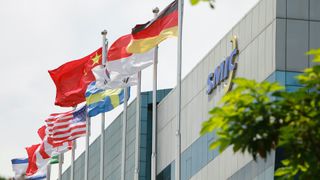China’s Largest Chipmaker Delays New Fab, Sanctions Likely Root Cause
SMIC has to delay deployment of a 300-mm fab due to lack of wafer fab equipment.

Semiconductor Manufacturing International Corp. (SMIC) recently said it would have to postpone the start of volume production at its fab near Beijing by one or two quarters "due to the delay of bottleneck equipment." This is the first announcement of this kind after the U.S. imposed its sweeping sanctions against the Chinese semiconductor sector back in October. But the delay might be caused not by the lack of American tools, but rather by delays of tools made in China.
Following the U.S. government's crackdown on SMIC's efforts to build chips using 10nm-class production nodes and thinner, China's leading foundry announced four major 28nm-capable 300-mm fabs to be built near Beijing (Jingcheng), Shanghai (Lingang), Shenzhen (Shenzhen), and Tianjin (Xiqing), to address global and local needs for mature production capacity. Jingcheng, Lingang, and Xiqing are all projected to be gigafabs with production capacity of at least 100,000 300-mm wafer starts per month (WSPM) when they are fully ramped in the coming years.
By the end of 2022, the relatively small fab near Shenzhen started production, construction of the Shanghai fab building was completed, and the company initiated the construction of the fab near Tianjin. Yet, while the Jingcheng fab near Beijing started pilot production, mass production at this facility will be postponed, as noted by ComputerBase.
It is unclear whether the delay is a direct result of the latest U.S. export rules that require American producers of advanced wafer fab equipment (WFE) to get an export license from the Department of Commerce to sell tools that can be used to make logic chips with non-planar transistors on 14nm/16nm nodes and below, but this is certainly a possibility. At the end of the day, modern tools that can be used to build 14nm chips can be used to make 28nm chips as well. In most cases, they will lead to increased productivity and will make SMIC's fabs more competitive. But it is possible that the latest U.S. export regulations didn't cause the delays of SMIC's Jingcheng fabs, at least not directly.
One of the goals that SMIC set for its gigafabs was to use as many domestic tools as possible, which would naturally help insulate from US sanctions. Analysts from China Renaissance Securities estimate that the fab could source 30% - 40% of its tools from Chinese companies like AMEC, Kingsemi, or Naura.
"SMIC Jincheng is now in pilot production and engaging clients for line qualification," Szeho Ng, an analyst with China Renaissance, wrote in a note for clients. "Our surveys indicate that SMIC Jincheng aims 30-40% domestic tool sourcing. We still hold the view that the US tech export restriction is limited to the FinFET areas."
It is unclear whether Chinese wafer fab equipment makers can fulfill all orders now that they cannot get technology from the U.S. without an appropriate export license and some of their engineers with U.S. citizenship cannot serve them without permission from the U.S. government.
Stay On the Cutting Edge: Get the Tom's Hardware Newsletter
Get Tom's Hardware's best news and in-depth reviews, straight to your inbox.
SMIC hasn't specified whether the latest U.S. export restrictions have any effect on
its abilities to equip its fabs, or whether its Chinese suppliers have delayed their tools. For now, the company maintains a plan to spend around $6.35 billion on manufacturing capacity, so the contract chipmaker fully expects to complete building and equipping all of its fab projects that it has.

Anton Shilov is a Freelance News Writer at Tom’s Hardware US. Over the past couple of decades, he has covered everything from CPUs and GPUs to supercomputers and from modern process technologies and latest fab tools to high-tech industry trends.
Most Popular

